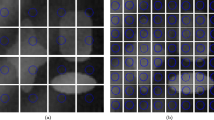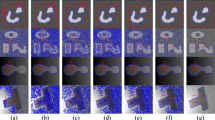Abstract
In this paper, we incorporate the global convex segmentation method and the split Bregman technique into the region-scalable fitting energy model. The new proposed method based on the region-scalable model can draw upon intensity information in local regions at a controllable scale, so that it can segment images with intensity inhomogeneity. Furthermore, with the application of the global convex segmentation method and the split Bregman technique, the method is very robust and efficient. By using a non-negative edge detector function to the proposed method, the algorithm can detect the boundaries more easily and achieve results that are very similar to those obtained through the classical geodesic active contour model. Experimental results for synthetic and real images have shown the robustness and efficiency of our method and also demonstrated the desirable advantages of the proposed method.
C.Y.K. is partially supported by NSF DMS-0811003 grant and Sloan Fellowship. S.O. is supported by an ARO MURI subcontract through the University of South Carolina.
Access this chapter
Tax calculation will be finalised at checkout
Purchases are for personal use only
Preview
Unable to display preview. Download preview PDF.
Similar content being viewed by others
References
Chan, T.F., Vese, L.A.: Active contours without edges. IEEE Trans. Image Process. 10, 266–277 (2001)
Cohen, L., Cohen, I.: Finite element methods for active contour models and balloons for 2d and 3d images. IEEE Trans. Pattern Anal. Mach. Intell. 15, 1131–1147 (1991)
Kass, M., Witkin, A., Terzopoulos, D.: Snakes: active contour models. Int. J. Comput. Vis. 1, 321–331 (1988)
Malladi, R., Sethian, J.A., Vemuri, B.C.: Shape modeling with front propagation: a level set approach. IEEE Trans. Pattern Anal. Mach. Intell. 17, 158–175 (1995)
Paragios, N., Deriche, R.: Geodesic active regions and level set methods for supervised texture segmentation. Int. J. Comput. Vis. 46, 223–247 (2002)
Ronfard, R.: Region-based strategies for active contour models. Int. J. Comput. Vis. 13, 229–251 (1994)
Samson, C., Blanc-Feraud, L., Aubert, G., Zerubia, J.: A variational model for image classification and restoration. IEEE Trans. Patt. Anal. Mach. Intell. 22, 460–472 (2000)
Tsai, A., Yezzi, A., Willsky, A.S.: Curve evolution implementation of the Mumford-Shah functional for image segmentation, denoising, interpolation, and magnification. IEEE Trans. Image Process. 10, 1169–1186 (2001)
Vese, L.A., Chan, T.F.: A multiphase level set framework for image segmentation using the Mumford and Shah model. Int. J. Comput. Vis. 50, 271–293 (2002)
Caselles, V., Kimmel, R., Sapiro, G.: Geodesic active contours. Int. J. Comput. Vis. 22, 61–79 (1997)
Kimmel, R., Amir, A., Bruckstein, A.: Finding shortest paths on surfaces using level set propagation. IEEE Trans. Pattern Anal. Mach. Intell. 17, 635–640 (1995)
Li, C., Xu, C., Gui, C., Fox, M.D.: Level set evolution without re-initialization: a new variational formulation. In: Conference on Computer Vision and Pattern Recognition, pp. 430–436. IEEE, Los Alamitos (2005)
Vasilevskiy, A., Siddiqi, K.: Flux maximizing geometric flows. IEEE Trans. Pattern Anal. Mach. Intell. 24, 1565–1578 (2001)
Hou, Z.: A review on MR image intensity inhomogeneity correction. Int. J. Biomed. Imag. (2006)
Mumford, D., Shah, J.: Optimal approximations by piecewise smooth functions and associated variational problems. Commun. Pure Appl. Math. 42, 577–685 (1989)
Michailovich, O., Rathi, Y., Tannenbaum, A.: Image segmentation using active contours driven by the Bhattacharyya gradient flow. IEEE Trans. Image Process. 16, 2787–2801 (2007)
Li, C., Kao, C., Gore, J.C., Ding, Z.: Minimization of region-scalable fitting energy for image segmentation. IEEE Trans. Imag. Proc. 17, 1940–1949 (2008)
Rudin, L., Osher, S., Fatemi, E.: Nonlinear total variation based noise removal algorithms. Physica. D., 259–268 (1992)
Goldstein, T., Osher, S.: The split Bregman method for L1 regularized problems. UCLA CAM Report 08-29 (2008)
Osher, S., Burger, M., Goldfarb, D., Xu, J., Yin, W.: An iterative regularization method for total variation-based image restoration. Simul. 4, 460–489 (2005)
Houhou, N., Thiran, J.P., Bresson, X.: Fast texture segmentation based on semi-local region descriptor and active contour. Numer. Math. Theor. Meth. Appl. 2, 445–468 (2009)
Goldstein, T., Bresson, X., Osher, S.: Geometric applications of the split Bregman method: segmentation and surface reconstruction. UCLA CAM Report 09-06 (2009)
Chan, T., Esedoglu, S., Nikolova, M.: Algorithms for finding global minimizers of image segmentation and denoising models. SIAM J. Appl. Math. 66, 1932–1948 (2006)
Li, C., Kao, C., Gore, J., Ding, Z.: Implicit active contours driven by local binary fitting energy. In: Conference on Computer Vision and Pattern Recognition, Washington, DC, USA, pp. 1–7. IEEE Computer Society, Los Alamitos (2007)
Osher, S., Sethian, J.A.: Fronts propagating with curvature dependent speed: algorithms based on Hamilton-Jacobi formulations. J. Comput. Phys. 79, 12–49 (1988)
Bresson, X., Esedoglu, S., Vandergheynst, P., Thiran, J., Osher, S.: Fast global minimization of the active contour/snake model. J. Math. Imag. Vis. 28, 151–167 (2007)
Author information
Authors and Affiliations
Editor information
Editors and Affiliations
Rights and permissions
Copyright information
© 2010 Springer-Verlag Berlin Heidelberg
About this paper
Cite this paper
Yang, Y., Li, C., Kao, CY., Osher, S. (2010). Split Bregman Method for Minimization of Region-Scalable Fitting Energy for Image Segmentation. In: Bebis, G., et al. Advances in Visual Computing. ISVC 2010. Lecture Notes in Computer Science, vol 6454. Springer, Berlin, Heidelberg. https://doi.org/10.1007/978-3-642-17274-8_12
Download citation
DOI: https://doi.org/10.1007/978-3-642-17274-8_12
Publisher Name: Springer, Berlin, Heidelberg
Print ISBN: 978-3-642-17273-1
Online ISBN: 978-3-642-17274-8
eBook Packages: Computer ScienceComputer Science (R0)




